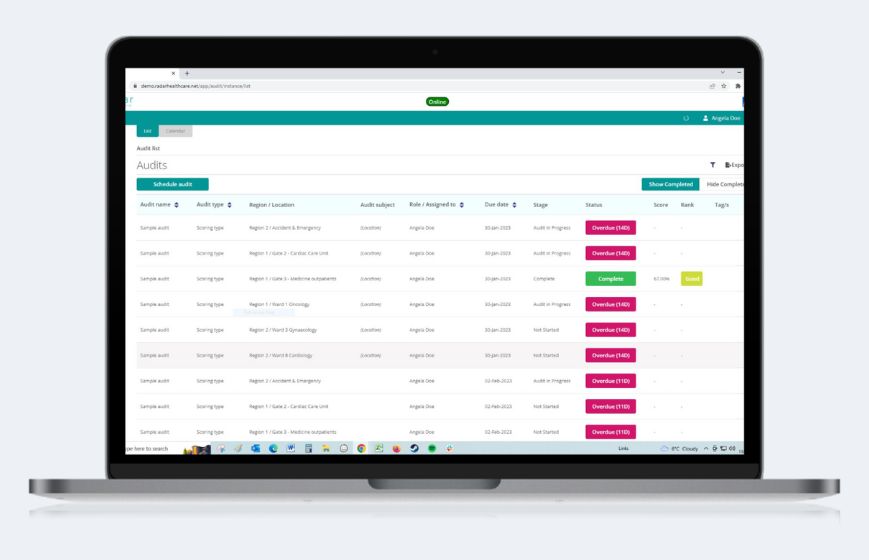Using After Action Reviews to Facilitate Learning
13 December 2022
Tags:
 An After Action Review (AAR) is a structured, facilitated discussion of an event that provides individuals involved with an understanding of why the outcome differed from what was expected. They exist to improve processes and to capture learning for the organisation which will aid future improvement.
An After Action Review (AAR) is a structured, facilitated discussion of an event that provides individuals involved with an understanding of why the outcome differed from what was expected. They exist to improve processes and to capture learning for the organisation which will aid future improvement.
AARs can be used in healthcare to evaluate both positive and negative outcomes that may affect patients, family members, and staff members. It does this by generating understanding from the diverse views and perspectives of multi-disciplinary teams (MDT); a group of health and care staff from various organisations and professions (e.g., GPs, nurses, and pharmacists) who collaborate to make treatment decisions for individual patients and service users.
An AAR asks four questions:
- What was the expected outcome?
- What was the actual outcome/what actually happened?
- What went well and why?
- What can we learn and how?
Typically, an AAR is used at the end of a project to help create a lessons-learned log. It is important to disseminate learning widely for good practice to be shared and to learn from any mistakes which were made.
“The fundamental principle of the After Action Review is that it flattens the hierarchy and enables people to learn together from the richness of their different experiences, and the research on this is really powerful.”
– Judy Walker, iTS Leadership, Episode 21 What the HealthTech?: After Action Review – How to Change Your Perception of Success
AARs as a key part of PSIRF
AARs are included in NHS England’s new Patient Safety Incident Response Framework (PSIRF) as a recommended tool to enhance learning from incidents and events as detailed here.
PSIRF’s four main aims are as follows:
- Compassionate engagement and involvement of those affected by patient safety incidents
- Application of a range of system-based approaches to learning from patient safety incidents
- Considered and proportionate responses to patient safety incidents
- Supportive oversight focused on strengthening response system functioning and improvement
As AARs recognise the importance of including all those affected by a success or failure to create an effective way of learning and implement improvement, they are particularly applicable to the PSIRF aims.
Radar Healthcare’s risk, quality, and compliance system is flexible to all learning response methods so you can choose the right one for your organisation and for the event you’re reviewing. Whatever learning response method you choose, our system allows you to improve your patient safety outcomes while also engaging their families and staff on a local and national scale.
Hearing from an AAR subject matter expert
We took a deep dive into the significance of AARs, their origin, and their efficiency over time in our recent ‘What the HealthTech?‘ podcast episode, which featured Judy Walker from iTS Leadership (subject matter expert in AARs). Judy has spent the last twelve years working with dozens of organisations in the NHS, higher education, and corporate settings to help them begin using AAR to improve the quality of learning after events. Listen to the full episode now.
How you can introduce AARs
Judy suggests four steps to ensure the successful implementation of AAR:
Step 1 – Ensure you’re engaging your leaders.
Step 2 – Train the staff who will be facilitating the review.
Step 3 – Educate your workforce.
Step 4 – Ensure the right structure is in place to record information.
“It is important to include as many people as possible who were involved in the incident or event so that a wide range of views can be discussed. It is also crucial that all participating members feel safe to contribute to the conversation without fear of blame or retribution. This is key, as AARs are about learning and not holding people accountable. It is also useful to have an independent facilitator involved, so they can guide the discussion and help create a safe and open atmosphere.”
– Judy Walker, iTS Leadership, Episode 21 What the HealthTech?: After Action Review – How to Change Your Perception of Success
How AARs can help you to improve patient safety outcomes
Brighton and Sussex University Hospitals NHS Trust published a study on how AARs help reduce the number of hospital falls. They saw some incredible results after routinely using After Action Reviews after every patient fall, making sure to include the patient, family members, and all staff who were directly involved. Over a five-year period, they reduced falls by 49%, saving thousands of patients’ lives and 1.3 million pounds.
Being able to map out themes that are emerging is extremely important. Radar Healthcare’s system enables you to keep a finger on the pulse by monitoring which teams have the most AAR activity. This, in turn, gives you a sign of where the healthy behaviours are and what key issues are developing.
“And this is where, the technology that Radar Healthcare has, it could be so, so powerful to enable an organisation to feel the heat spots.”
– Judy Walker, iTS Leadership, Episode 21 What the HealthTech?: After Action Review – How to Change Your Perception of Success
Radar Healthcare’s experience in understanding the importance of patient safety means we work in collaboration with our NHS partners to ensure our software works around for what they need to achieve – we don’t have a ‘one-size fits all’ approach – it’s about the objectives of the organisation.
PSIRF and LFPSE are changing the way you do things, which is why we’re here to help you to make a difference and ensure you have what you need to improve patient outcomes.
This article has been created to inform as part of our duty to our partners and industry peers. For legal issues, we always recommend seeking specific guidance. Our links to third-party websites are done to further educate on the subject we directly cover. We have no control over them and are not responsible for their content.










